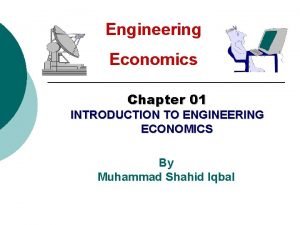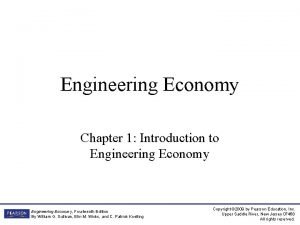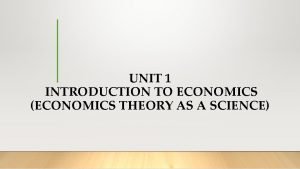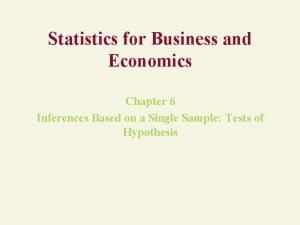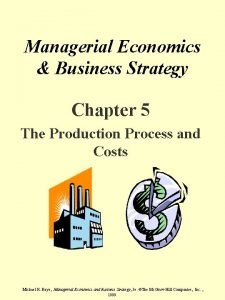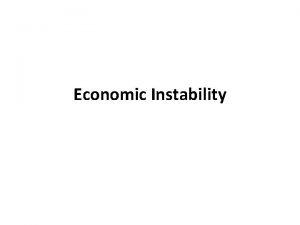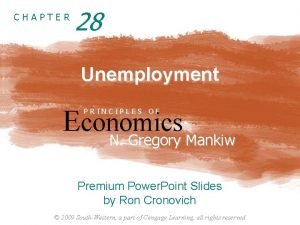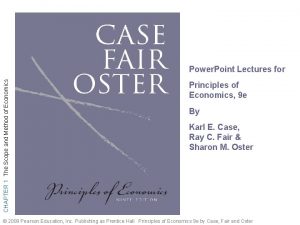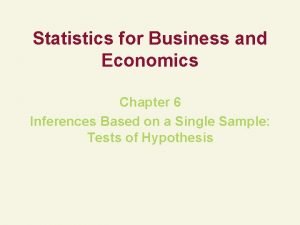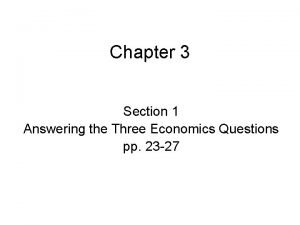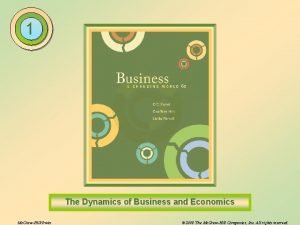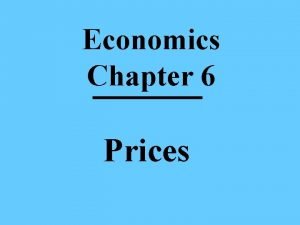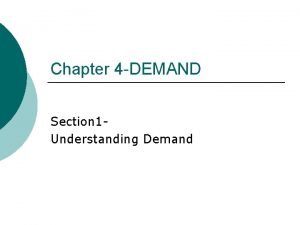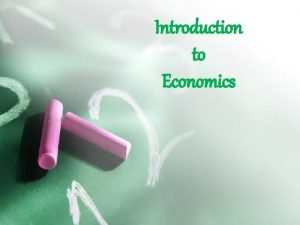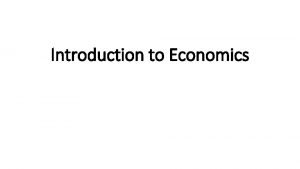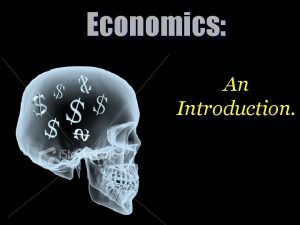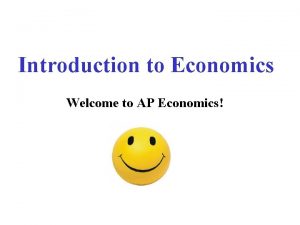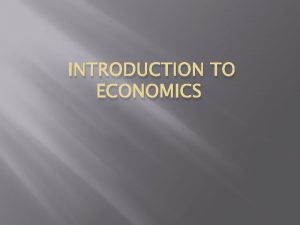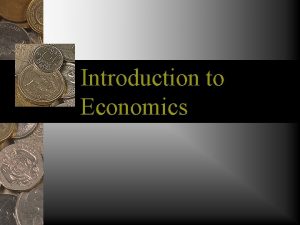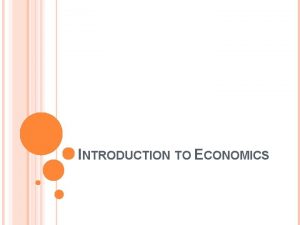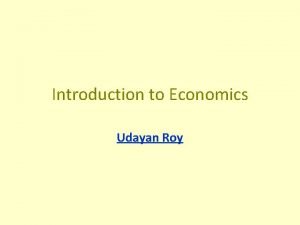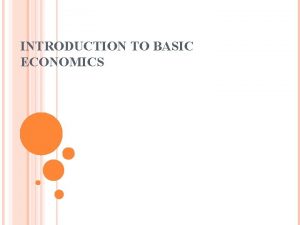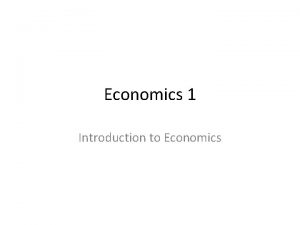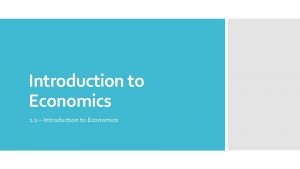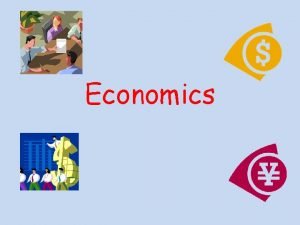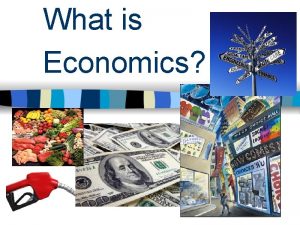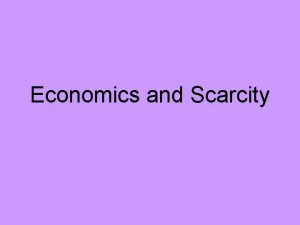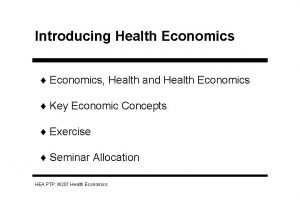ECONOMICS Chapter 1 Introduction to Economics Chapter 1



















- Slides: 19

ECONOMICS Chapter 1: Introduction to Economics Chapter 1 Section Main Menu

Chapter 1, Section 1: Scarcity and Factors of Production Essential Questions 1. Why are scarcity and choice the basic problems of economics? 2. What are three factors of production? (Define each). 3. What are the two types of capital? (Define each). 4. What is the role of entrepreneurs? 5. Why do economists say all resources are scarce? Chapter 1 Section Main Menu

Ch 1, Section 1 Notes: Scarcity and Choice • The study of economics begins with the idea that people cannot have everything they need or want. • Need: something like air, food, or shelter and is necessary for survival. • Want: at item that we desire but is not essential to survival. • What is economics? The study of how people make choices to satisfy their wants and needs. Chapter 1 Section Main Menu

Ch 1, Section 1 Notes: Scarcity • Living in a relatively wealthy country like America it is difficult to understand the idea of scarcity. • Scarcity occurs when there are limited quantities of resources to meet unlimited needs or desires • Shortages occur when producers will not or cannot offer goods or services at current prices • Not the same thing as scarcity • Goods: physical objects such because scarcity always as shirts or shoes. exists. Shortages can be temporary. • Services: actions or activities that one person performs for another. Chapter 1 Section Main Menu

Ch 1, Section 1 Notes: The Factors of Production • In addition to producing capital, people invest in themselves. • Land: All natural resources that are used to produce goods and services. • Labor: Any effort a person devotes to a task for which that person is paid. • Capital: Any human-made resource that is used to create other goods and services. • Physical Capital: Human made objects used to create goods and services. • Human capital: The knowledge and skills a worker gains through education and experience. Chapter 1 Section Main Menu

Ch 1, Section 1 Notes: The Factors of Popcorn Production Land Labor Capital Popping Corn The human effort needed to pop the corn Corn-Popping Device Vegetable Oil Chapter 1 Section Main Menu

Chapter 1, Section 1: Factors of Production Closing Activity 1. Create an illustration that shows the three factors of production. Under each category, write a brief description of the factor. Due at end of class. 10 points. Want to connect to the PHSchool. com link for this section? Click Here! Chapter 1 Section Main Menu

Chapter 1, Section 2: Opportunity Cost Essential Questions 1. Why does every decision you make involve trade-offs? 2. What is the concept of opportunity cost? (Fully explain). 3. How will thinking at the margin affect decisions you make? Chapter 1 Section Main Menu

Ch 1, Section 2 Notes: Trade-offs and Opportunity Cost • Trade-offs: are all the alternatives that we give up whenever we choose one course of action over others. • Economists say that all individuals, businesses, and governments make decisions that involve trade offs. • All individuals and groups of people make decisions that involve trade-offs. • Guns and Butter: Refers to trade offs that nations face when choosing to make more or less military goods or consumer goods. • Opportunity Cost: The most desirable alternative given up as a result of a decision. Chapter 1 Section Main Menu

The Decision-Making Grid • Economists encourage us to consider the benefits and costs of our decisions. Karen’s Decision-making Grid Alternatives Sleep late Wake up early to study Benefits • Enjoy more sleep • Have more energy during the day • Better grade on test • Teacher and parental approval • Personal satisfaction Decision • Sleep late • Wake up early to study for test Opportunity cost • Extra study time • Extra sleep time Benefits forgone • Better grade on test • Teacher and parental approval • Personal satisfaction • Enjoy more sleep • Have more energy during the day Chapter 1 Section Main Menu

Thinking at the Margin • Economists look at decisions with one additional characteristic. • Many decisions involve the adding or subtracting of one additional unit (like one minute or one dollar). • When you decide how much more or less to do, you are thinking at the margin. Options Benefit Opportunity Cost 1 st hour of extra study time Grade of C on test 1 hour of sleep 2 nd hour of extra study time Grade of B on test 2 hours of sleep 3 rd hour of extra study time Grade of B+ on test 3 hours of sleep Chapter 1 Section Main Menu

Section 2 Assessment 1. Complete the Trade Offs and Opportunity Cost worksheet (Chapter 1, Section 2). Turn in at the end of class. 10 points. Want to connect to the PHSchool. com link for this section? Click Here! Chapter 1 Section Main Menu

Chap 1, Sec 3: Production Possibilities Graphs Essential Questions 1. How do you interpret a production possibilities graph? 2. How do production possibilities graphs show efficiency, growth, and cost? 3. Why are production possibilities frontiers curved lines? 4. Why does a country’s production possibilities depend on its available resources and technology? Chapter 1 Section Main Menu

Production Possibilities • Economists often use graphs to analyze the choices and trade-offs that people make. • A production possibilities graph shows alternative ways that an economy can use its resources. • The production possibilities frontier is the line that shows the maximum possible output for that economy. Production Possibilities Graph 15 Shoes (millions of 14 pairs) 14 12 18 9 20 5 21 0 25 Shoes (millions of pairs) 0 Watermelons (millions of tons) 8 20 Section b (8, 14) c (14, 12) d (18, 9) 15 10 5 0 Chapter 1 a (0, 15) A production possibilities frontier e (20, 5) f (21, 0) 5 10 15 20 Watermelons (millions of tons) Main Menu 25

Efficiency • An economy producing output levels on the production possibilities frontier is operating efficiently. • Underutilization: any point inside the line indicates, using fewer resources that an economy is capable of using. Chapter 1 Section Production Possibilities Graph 25 Shoes (millions of pairs) • Efficiency: means using resources in such a way as to maximize the production of goods and services. 20 S 15 a (0, 15) 10 b (8, 14) c (14, 12) g (5, 8) 5 d (18, 9) e (20, 5) A point of underutilization 0 5 10 f (21, 0) 15 20 Watermelons (millions of tons) Main Menu 25

Growth • When this happens, the entire production possibilities curve “shifts to the right. ” Production Possibilities Graph 25 Future production Possibilities frontier T Shoes (millions of pairs) • Growth: If more resources become available, or if technology improves, an economy can increase its level of output and grow. 20 S 15 a (0, 15) b (8, 14) c (14, 12) 10 d (18, 9) 5 e (20, 5) f (21, 0) 0 5 10 15 20 Watermelons (millions of tons) Chapter 1 Section Main Menu 25

Cost • Cost: A production possibilities graph shows the cost of producing more of one item. • Law of increasing costs: states that as we shift factors of production from making one good or service to another, the cost of producing the second item increases. • To move from point c to point d on this graph has a cost of 3 million pairs of shoes. Production Possibilities Graph Shoes (millions of pairs) 15 8 14 14 12 18 9 20 5 21 0 Chapter 1 Section 25 Shoes (millions of pairs) Watermelons (millions of tons) 0 20 c (14, 12) d (18, 9) 15 10 0 5 Main Menu 5 10 15 20 Watermelons (millions of tons) 25

Resources and Technology • When economists collect data to create a production possibilities curve, they must determine which goods or services a country can produce given its current available resources. • Includes land, labor, and capital of that country. • Each kind of production method uses different technology. • Economists must assess each country’s level of technology. Chapter 1 Section Main Menu

Chapter 1, Section 3 Assessment 1. Create a web diagram that shows the concept of opportunity cost and trade-offs. In the organizer explain what a production possibilities graph can show. Due at end of class. 10 points. Want to connect to the PHSchool. com link for this section? Click Here! Chapter 1 Section Main Menu
 Maastricht university economics and business economics
Maastricht university economics and business economics Mathematical economics vs non mathematical economics
Mathematical economics vs non mathematical economics Branches of economics
Branches of economics Scope of engineering economics
Scope of engineering economics Unit 1 economics
Unit 1 economics Introduction to engineering economics
Introduction to engineering economics Unit 1 introduction to economics
Unit 1 introduction to economics Conclusion paragraph format
Conclusion paragraph format Statistics for business and economics chapter 6 solutions
Statistics for business and economics chapter 6 solutions Ecomics
Ecomics Chapter 13 economic instability
Chapter 13 economic instability Chapter 28 unemployment
Chapter 28 unemployment The scope and method of economics chapter 1
The scope and method of economics chapter 1 Statistics for business and economics chapter 6 solutions
Statistics for business and economics chapter 6 solutions Economics chapter 3 section 1 answer key
Economics chapter 3 section 1 answer key Chapter 1 ten principles of economics
Chapter 1 ten principles of economics Chapter 1 the dynamics of business and economics
Chapter 1 the dynamics of business and economics Environmental science chapter 2
Environmental science chapter 2 Chapter 6 section 1 economics
Chapter 6 section 1 economics Economics chapter 4 section 1 understanding demand answers
Economics chapter 4 section 1 understanding demand answers



